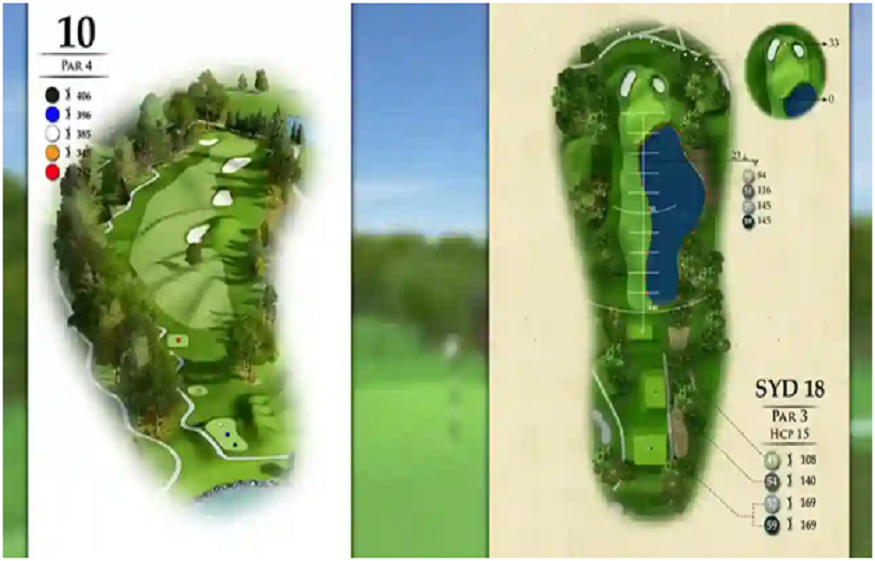Golf Course 3D Visualization Services are changing how developers, architects, and investors conceptualize, design, and present golf projects. Even before a tee box is built or a bunker is formed, clients can experience the course layout, terrain, and aesthetics virtually. These visualizations transform traditional blueprints into detailed, realistic virtual landscapes, improving design accuracy and inspiring investor confidence. Using powerful 3D flyovers, realistic lighting, and fully enclosed models, designers create a visual narrative that connects the imagination with reality through the construction of a golf project.
1.Improve Course Planning with 3D Golf Course Models
- Accurate portrayal of terrain and elevation data
- Realistic water, vegetation, and bunker details
- Rapid iteration and comparison options
3D Golf course models ease the early stages of the planning process, by allowing design teams to visualize the landscape and refine spatial options. From flow on the fairway to the location of bunkers, the advanced graphic representation of golf course design enables communication about aesthetic beauty in conjunction with playability and harmony with the environment prior to final approval or ground breaking.
2. Golf Course Flythroughs for Client Presentation
- High-impact 3D visualization flyover with cinematic movements
- Variety of seasonal and light conditions to simulate previews
- Interactive formats to engage clients
3D flythrough animations enhance project presentations by allowing stakeholders to take a cinematic tour of the course. These visual stories allow the clients to ‘walk through’ the property, envision gameplay, and emotionally resonate with the design vision, things that static drawings will never do.
3. Enhanced Collaboration by Using 3D Visualization Tools
- Real-time collaboration and review tools
- Integration with CAD, BIM and GIS platforms
- Cloud-based sharing for global access
3D visualization tools allow design teams and stakeholders to collaborate from anywhere. Real-time updates, interactivity, and model sharing initiate faster feedback loops, which help with decision-making, producing a shared design vision from concept to completion.
4. Realistic Environmental and Lighting Simulation
- Sun path, shadow, and seasonal light studies
- Realistic weather simulations for visual testing
- Visual consistency across time-of-day views
Environmental simulations in 3D visualization define how light, shadow, and climate inform playability and aesthetics. This communicative realism or level of fidelity not only enhances visual quality, it also ensures the design employs situations in the real world, year-round, as intended.
5. Cost Efficiency and Time Savings Through Visualization
- Identifies issues early in the design stage
- Reduce rework and physical modeling costs
- Accelerates investor approval and marketing
Utilizing 3D visualization technology ultimately mitigates expensive changes after the design stage, as potential issues are identified at the concept stage. The old-school way of mock-ups is replaced with digital representations. The process restricts costs around production and shortens the time frame of the project, allowing the design team to facilitate communication with stakeholders and provide clarity with visuals.
1. From your Concept Sketch to Your Photorealistic Rendering
Every world-renowned golf course starts as a concept that requires a balance of creativity and logic. The 3D visualization process converts your early sketch into beautiful renderings with realistic lighting, texturing, and landscaping. The technology enables designers to play with their hole configurations, water hazards, and elevations prior to breaking ground.
2. Interactive Golf Course Design Review Meetings
Interactive 3D models facilitate project teams to view the course from every angle, in a real-life context. Stakeholders will be able to move hole locations, increase or shrink fairway widths, or add or remove vegetation densities to assure that the aesthetic vision is met with proper playing conditions. These facilitated interactions lead to better decision-making and a more collaborative project.
3. Marketing and Promotion of Your Golf Course through 3D Visualization
3D is a great avenue to help developers and golf clubs market their developments to an audience, either through promotional campaigns across various platforms websites, or live presentations to investors or sponsors. In conjunction with photorealistic visuals and video flyovers, audiences become engaged and golf clubs can garner sponsors upfront or sell memberships before breaking ground. Regardless of the project, marketing will produce a powerful engagement vehicle for prospective members and clients, where the prospect of seeing your course in a physical state leads to confidence in the development.
4. Integration of Aerial Data and Drone Mapping
Geoshot golf course visualization services often integrate aerial drone data and GIS mapping to ensure precise elevation modeling. This data-driven approach ensures the visuals are not only artistic but also technically accurate, aligning perfectly with real-world site conditions and topographic data.
5. Virtual Reality (VR) and Augmented Reality (AR) Golf Course Visualization
VR and AR technologies take 3D visualization to the next level. Developers and clients can immerse themselves in a virtual golf experience, exploring the terrain and testing design elements interactively. This technology enhances stakeholder engagement and adds a new dimension to design validation.
FAQs
- What is golf course 3D visualization?
Golf course 3D visualization is the process of creating realistic digital models and animations of golf courses. It helps stakeholders view the project layout, topography, and gameplay experience virtually before construction starts. - How does 3D visualization benefit golf course design?
It improves design accuracy, enhances visual communication, reduces costly errors, and provides realistic previews that simplify decision-making and investor presentations. - Can 3D visualization integrate with CAD and drone data?
Yes, Geoshot’s 3D visualization services integrate CAD files, GIS maps, and drone-captured topography to ensure models are precise and true to the site’s actual terrain. - Is 3D visualization useful for marketing golf courses?
Absolutely. Photorealistic 3D renders, walkthroughs, and animations are ideal for promotional use, helping developers attract buyers, sponsors, and investors with immersive visual content. - How long does it take to create a 3D golf course visualization?
The timeline depends on the project’s complexity, but typically ranges from 2 to 4 weeks for complete 3D modeling, texturing, rendering, and animation delivery.













